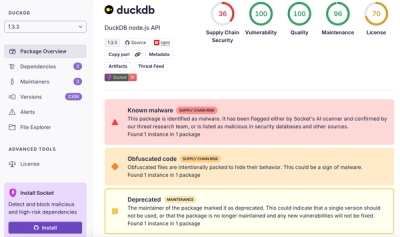
Product
Introducing Tier 1 Reachability: Precision CVE Triage for Enterprise Teams
Socket’s new Tier 1 Reachability filters out up to 80% of irrelevant CVEs, so security teams can focus on the vulnerabilities that matter.
ts-deepmerge
Advanced tools
A deep merge function that automatically infers the return type based on your input, without mutating the source objects.
Objects and arrays will be merged, but values such as numbers and strings will be overwritten.
All merging/overwriting occurs in the order of the arguments you provide the function with.
Both ESM and CommonJS are supported by this package.
import { merge } from "ts-deepmerge";
const obj1 = {
a: {
a: 1
}
};
const obj2 = {
b: {
a: 2,
b: 2
}
};
const obj3 = {
a: {
b: 3
},
b: {
b: 3,
c: 3
},
c: 3
};
const result = merge(obj1, obj2, obj3);
The value of the above result is:
{
"a": {
"a": 1,
"b": 3
},
"b": {
"a": 2,
"b": 3,
"c": 3
},
"c": 3
}
If you would like to provide options to change the merge behaviour, you can use the .withOptions method:
import { merge } from "ts-deepmerge";
const obj1 = {
array: ["A"],
};
const obj2 = {
array: ["B"],
}
const result = merge.withOptions(
{ mergeArrays: false },
obj1,
obj2
);
The value of the above result is:
{
"array": ["B"]
}
All options have JSDoc descriptions in its source.
There's currently a limitation with the inferred return type that ts-deepmerge offers, where it's
unable to take the order of the objects/properties into consideration due to the nature of accepting
an infinite number of objects to merge as args and what TypeScript currently offers to infer the types.
The primary use case for the inferred return type is for basic object primitives, to offer something
more useful as the return type, which does work for a lot of cases.
If you're working with generic declared types though, this can cause the inferred return type to not align
with what you may expect, as it currently detects every possible value and combines them as a union type.
When working with declared types, and you know what the final type will align to, simply use the as keyword
as shown in the example below:
interface IObj {
a: string;
b: string;
}
const obj1: IObj = { a: "1", b: "2", };
const obj2: Partial<IObj> = { a: "1" };
const result = merge(obj1, obj2) as IObj;
More context can be found in this issue.
FAQs
A TypeScript deep merge function.
The npm package ts-deepmerge receives a total of 758,209 weekly downloads. As such, ts-deepmerge popularity was classified as popular.
We found that ts-deepmerge demonstrated a healthy version release cadence and project activity because the last version was released less than a year ago. It has 1 open source maintainer collaborating on the project.
Did you know?

Socket for GitHub automatically highlights issues in each pull request and monitors the health of all your open source dependencies. Discover the contents of your packages and block harmful activity before you install or update your dependencies.

Product
Socket’s new Tier 1 Reachability filters out up to 80% of irrelevant CVEs, so security teams can focus on the vulnerabilities that matter.

Research
/Security News
Ongoing npm supply chain attack spreads to DuckDB: multiple packages compromised with the same wallet-drainer malware.

Security News
The MCP Steering Committee has launched the official MCP Registry in preview, a central hub for discovering and publishing MCP servers.